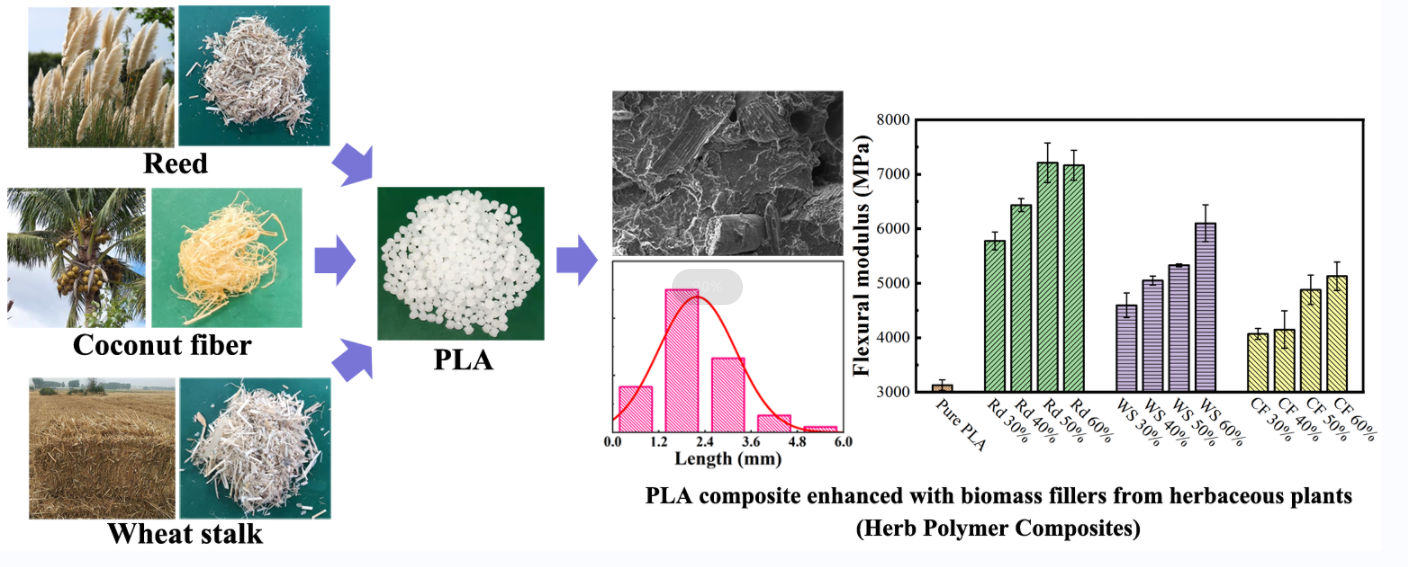 Open Access
Open Access
ARTICLE
Structure and Properties of PLA Composite Enhanced with Biomass Fillers from Herbaceous Plants
1
Key Laboratory of Bio-Based Polymeric Materials of Zhejiang Province, Ningbo Institute of Materials Technology and Engineering,
Chinese Academy of Sciences, Ningbo, 315201, China
2
Weifang Yunding New Material Technology Company Limited, Weifang, 262100, China
3
Jilin Hwood Technology Company Limited, Dunhua, 133712, China
* Corresponding Authors: Haining Na. Email: ; Jin Zhu. Email:
(This article belongs to the Special Issue: Natural Fibre Composites: Design, Materials Selection and Fabrication)
Journal of Renewable Materials 2023, 11(2), 491-503. https://doi.org/10.32604/jrm.2023.024181
Received 26 May 2022; Accepted 01 August 2022; Issue published 22 September 2022
Abstract
PLA composites containing biomass fillers from the three herbaceous plants such as reed, wheat stalk, and coconut fiber with length and diameter at the scale of several millimeters were prepared without using additives. The reinforcement effect on the properties of PLA/biomass filler composites is investigated. The research results show that the PLA/biomass filler composites exhibit good stiffness, flexural strength, and impact toughness. Among the three kinds of biomass fillers, reed reinforced PLA composites show optimal mechanical properties. When filled with 40%–50% reed, the flexural moduli of the composites are over 7000 MPa. Flexural strength retains at the same level of pure PLA. The notch impact strength reaches to 4.50 ± 0.73 kJ/m2 , which is 2.06 times higher than that of pure PLA. Furthermore, the introduction of biomass fillers increases the crystallization ability of PLA and does not increase the water absorption of the composites. This research demonstrated that PLA composites prepared with biomass fillers from the herbaceous plants (namely herb plastic composites, HPCs) is a material with good comprehensive mechanical properties while retaining the intrinsic particularity of biological sources.Graphic Abstract

Keywords
Cite This Article
 Copyright © 2023 The Author(s). Published by Tech Science Press.
Copyright © 2023 The Author(s). Published by Tech Science Press.This work is licensed under a Creative Commons Attribution 4.0 International License , which permits unrestricted use, distribution, and reproduction in any medium, provided the original work is properly cited.


 Submit a Paper
Submit a Paper Propose a Special lssue
Propose a Special lssue View Full Text
View Full Text Download PDF
Download PDF Downloads
Downloads
 Citation Tools
Citation Tools